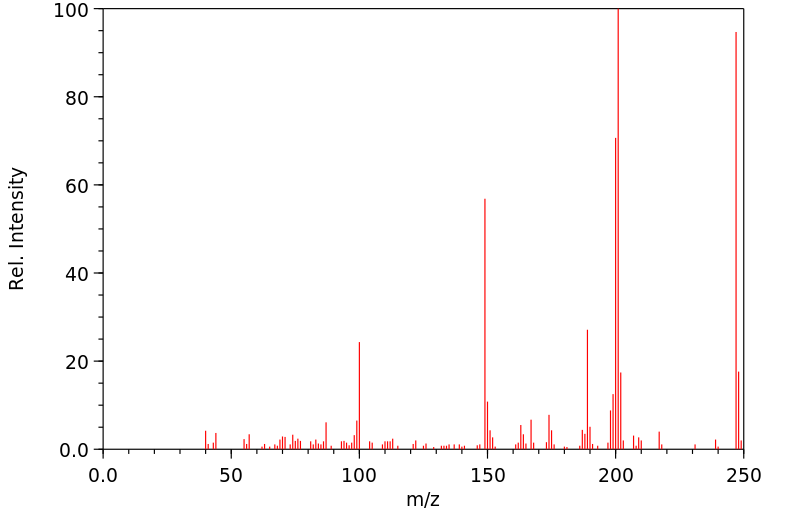1-硝基荧蒽 | 13177-28-1
中文名称
1-硝基荧蒽
中文别名
——
英文名称
1-Nitrofluoranthene
英文别名
2-Nitrofluoranthene;1-nitrofluorantene;1-nitro-fluoranthene;1-Nitro-fluoranthen;1-Nitrofluoranten
CAS
13177-28-1
化学式
C16H9NO2
mdl
——
分子量
247.253
InChiKey
AWYZHUPAWKZJSL-UHFFFAOYSA-N
BEILSTEIN
——
EINECS
——
-
物化性质
-
计算性质
-
ADMET
-
安全信息
-
SDS
-
制备方法与用途
-
上下游信息
-
文献信息
-
表征谱图
-
同类化合物
-
相关功能分类
-
相关结构分类
物化性质
-
沸点:455.7±14.0 °C(Predicted)
-
密度:1.422±0.06 g/cm3(Predicted)
-
保留指数:404.37;404.71;405.38;407.95;404.71
计算性质
-
辛醇/水分配系数(LogP):4.3
-
重原子数:19
-
可旋转键数:0
-
环数:4.0
-
sp3杂化的碳原子比例:0.0
-
拓扑面积:45.8
-
氢给体数:0
-
氢受体数:2
安全信息
-
海关编码:2904209090
SDS
上下游信息
反应信息
-
作为反应物:参考文献:名称:2-取代的荧光素的制备摘要:DOI:10.1039/jr9540000867
-
作为产物:参考文献:名称:亚硝基,亚硝基和氨基氟蒽的合成与表征摘要:报道了五个单硝基氟蒽的合成。1-硝基荧蒽由20%的荧蒽合成,2-硝基荧蒽由24%的1,2,3,10b-四氢荧蒽,3-硝基荧蒽由荧蒽合成的13%和7-和8-硝基荧蒽由1,2合成的34% ,3,10b-四氢荧蒽。纯的硝基氟蒽被转化为其亚硝基和氨基类似物。还合成了亚硝基吡啶。描述了每种化合物的表征。DOI:10.1002/recl.19921110701
文献信息
-
Reaction of dinitrogen pentoxide with fluoranthene作者:Barbara. Zielinska、Janet. Arey、Roger. Atkinson、Thomas. Ramdahl、Arthur M. Winer、James N. PittsDOI:10.1021/ja00274a045日期:1986.7The products and mechanisms of the reactions of dinitrogen pentoxide (N/sub 2/O/sub 5/) with fluoranthene (FL) in aprotic solvents have been investigated. The influence of solvent polarity and temperature and the effects of addition of HNO3 on the resulting nitrofluoranthene (NFL) isomer distributions have been studied. These data are compared with the NFL isomer distributions resulting from the reactions研究了五氧化二氮 (N/sub 2/O/sub 5/) 与荧蒽 (FL) 在非质子溶剂中的反应产物和机理。已经研究了溶剂极性和温度的影响以及添加 HNO3 对所得硝基荧蒽 (NFL) 异构体分布的影响。这些数据与由 FL 与 N/sub 2/O/sub 5/ 和其他硝化剂在气相和吸附相中反应产生的 NFL 异构体分布进行比较。在气相和环境温度下的 CCl4 溶液中,2-NFL 是唯一由 FL 与 N/sub 2/O/sub 5/ 反应形成的单硝基异构体。然而,在更极性的溶剂(CH/sub 3/CN 和 CH/sub 3/NO/sub 2/)和 CCl/sub 4/ 中,在低于环境温度 (-15/sup 0/C) 以及 FL在吸附状态下,与 N/sub 2/O/sub 5/ 反应仅产生 3-、8-、7- 和 1-NFL 异构体。假设形成 2-NFL 异构体的均裂机制
-
Formation of Mutagenic Nitrofluoranthenes in the Gas-Solid Heterogeneous Reaction of Particle-associated Fluoranthene in NO<sub>2</sub>-O<sub>3</sub>-O<sub>2</sub>System作者:Koji Inazu、Takaaki Kobayashi、Yoshiharu HisamatsuDOI:10.1246/cl.1996.1105日期:1996.12In the gas-solid heterogeneous reactions of particle-supported fluoranthene with ppm levels of nitrogen dioxide and ozone, dinitrofluoranthenes and 3-nitrofluoranthene (3-NF) were formed only in the dark and 2-NF was formed only under photoirradiation while 1-, 7-, and 8-NFs were formed under both conditions. Yield and distribution of the products varied depending on the kind of supports employed.
-
Process for detection of aflatoxins申请人:BOSTON UNIVERSITY公开号:EP0196787A1公开(公告)日:1986-10-08An affinity matrix and a method for the detection of low molecular weight compositions such as aflatoxins are provided utilizing specific monoclonal IgM antibody having an affinity constant not less than about 1 x 109 liters per mole. Methods for the preparation and use of such affinity matrices are also given. The detection is rapid, accurate, reproducible, and allows for quantitative recovery of the composition of interest.
-
Electrochemical sensors申请人:ISIS Innovation LTD.公开号:US10233084B2公开(公告)日:2019-03-19An electrode for use in a electrochemical sensor comprises carbon modified with a chemically sensitive redox-active compound, excluding an electrode based on carbon having derivatized thereon two redox-active species wherein at least one of said species is selected from anthraquinone, phenanthrenequinone and N,N′-diphenyl-p-phenylenediamine (DPPD). The invention further provides a pH sensor comprising: a working electrode comprising carbon modified with a chemically sensitive redox active material; and a counter electrode, wherein the ratio of the surface area of the working electrode to the surface area of the counter electrode is from 1:10 to 10:1. Also provided is a pH sensor comprising: a working electrode comprising carbon modified with a chemically sensitive redox active material, and a counter electrode, wherein the area of the working electrode is from 500 μm2 to 0.1 m2. The uses of these electrodes and sensors are also described.
-
Rates of protodetritiation of polycyclic aromatic hydrocarbons in trifluoroacetic acid作者:Andrew Streitwieser、Adolphus Lewis、Irving Schwager、Richard W. Fish、Santokh LabanaDOI:10.1021/ja00725a024日期:1970.11
表征谱图
-
氢谱1HNMR
-
质谱MS
-
碳谱13CNMR
-
红外IR
-
拉曼Raman
-
峰位数据
-
峰位匹配
-
表征信息
同类化合物
(S)-溴烯醇内酯
(R)-3,3''-双([[1,1''-联苯]-4-基)-[1,1''-联萘]-2,2''-二醇
(3S,3aR)-2-(3-氯-4-氰基苯基)-3-环戊基-3,3a,4,5-四氢-2H-苯并[g]吲唑-7-羧酸
(3R,3’’R,4S,4’’S,11bS,11’’bS)-(+)-4,4’’-二叔丁基-4,4’’,5,5’’-四氢-3,3’’-联-3H-二萘酚[2,1-c:1’’,2’’-e]膦(S)-BINAPINE
(11bS)-2,6-双(3,5-二甲基苯基)-4-羟基-4-氧化物-萘并[2,1-d:1'',2''-f][1,3,2]二氧磷
(11bS)-2,6-双(3,5-二氯苯基)-4羟基-4-氧-二萘并[2,1-d:1'',2''-f][1,3,2]二氧磷杂七环
(11bR)-2,6-双[3,5-双(1,1-二甲基乙基)苯基]-4-羟基-4-氧化物-二萘并[2,1-d:1'',2''-f][1,3,2]二氧杂磷平
黄胺酸
马兜铃对酮
马休黄钠盐一水合物
马休黄
食品黄6号
食品红40铝盐色淀
飞龙掌血香豆醌
颜料黄101
颜料红70
颜料红63
颜料红53:3
颜料红5
颜料红48单钠盐
颜料红48:2
颜料红4
颜料红261
颜料红258
颜料红220
颜料红22
颜料红214
颜料红2
颜料红19
颜料红185
颜料红184
颜料红170
颜料红148
颜料红147
颜料红146
颜料红119
颜料红114
颜料红 9
颜料红 21
颜料橙7
颜料橙46
颜料橙38
颜料橙3
颜料橙22
颜料橙2
颜料橙17
颜料橙 5
颜料棕1
顺式-阿托伐醌-d5
雄甾烷-3,17-二酮







